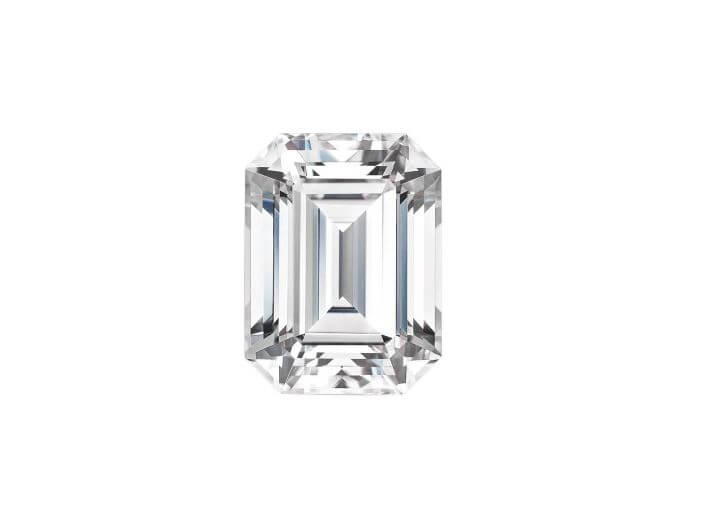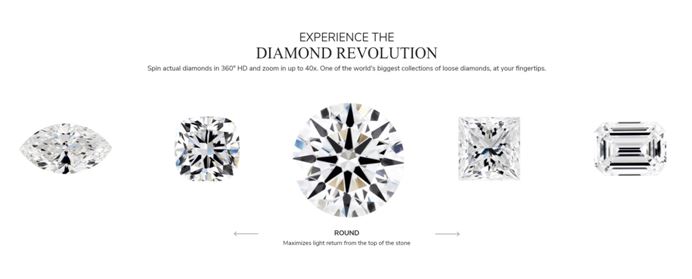The emerald cut was originally created for emerald gems but has become a popular cut to be used for diamonds. It is an unforgiving cut and requires only the highest quality diamond in order for the cut to be fully appreciated.
Emerald Cut Diamonds are fast becoming a popular choice for rings, as they make fingers look slender and longer. The cut itself also makes the diamond appear larger than it is, with emerald cut diamonds having almost a 5% greater surface area than that of a round cut diamond.
The emerald cut diamond is considered a vintage cut and appeals to those who appreciate it’s unique antique-style beauty. The versatility of the cut allows it to be set in a number of shapes and settings, providing wider options for those looking to purchase this diamond cut.
The Emerald Cut
The emerald cut diamond is rectangular in shape with trimmed corners and facets which are step-cuts, which are usually parallel to the girdle. The term ‘step-cut’ comes from the step-like appearance of the facet cuts.
The step-cut of the emerald diamond causes it to appear to have less brilliance than that of a princess or round cut diamond, but this isn’t completely the case. The sparkle and brilliance of an emerald diamond are more subtle, but it is still there. The broad flat plane of the cut highlights the natural crystalline rectangular shape of the diamond
The step-cut of the emerald diamond helps to create flashes of light that imitate a hall of mirrors. This is an illusion that creates flashes of bright white light that work in contrast with the dark planes in the different steps. While the cut might cause the diamond to appear less fiery, the dramatic flashes of light and the long lines give it a sophisticated and elegant look.
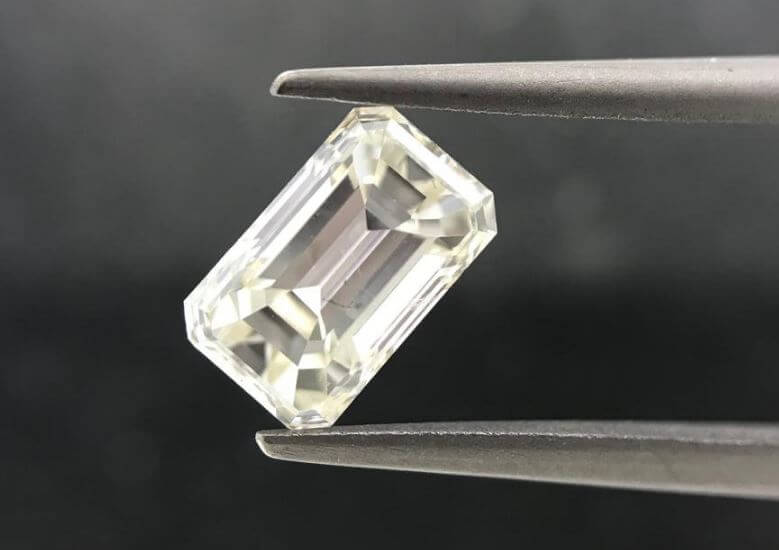
An emerald diamond can have between 50 to 58 facets. This number depends on the number of rows in the pavilion and the crown. An ideal length to width ratio for an emerald cut diamond is 1.5-1.7 to 1.
The ideal cut of an emerald diamond falls within the ratio of 1.30 and 1.50, and 1.40 is considered ideal. Lower ratios can be chosen if a squarer cut is preferred, and higher ratios should be chosen for more rectangular cuts.
This guide shows the ratios for square and rectangular emerald cut diamonds:
| Excellent | Very Good | Good | Fair | Poor | |
| Square | 1.00-1.03 | 1.00-1.03 | 1.04-1.05 | 1.06-1.08 | Greater than 1.08 |
| Rectangle | 1.40-1.50 | 1.30-1.39 / 1.51-1.60 | 1.20-1.29 / 1.61-1.80 | 1.15-1.19 / 1.81-1.90 | Less than 1.15 / Greater than 1.90 |
Below is a cut guide for an emerald diamond:
| Excellent | Very Good | Good | Fair | Poor | |
| Table (%) | 61-69 | 57-60 / 70-72 | 54-56 / 73-74 | 51-53 / 75-79 | Less than 51 / Greater than 79 |
| Depth (%) | 61-67 | 59-60.9 / 67.1-70 | 57-58.9 / 70.1-74 | 54-56.9 / 74.1-79 | Less than 54 / Greater than 79 |
| Girdle | Very Thin / Thick | Very Thin / Thick | Very Thin / Thick | Very Thin / Very Thick | Ex. Thin / Ex. Thick |
| Cutlet | None | Very Small | Small | Medium | Great than Medium |
Analyzing Color of an Emerald Cut
Diamonds do come in a range of colors, and some are highly valued such as pinks and blues, but when it comes to white diamonds, any color tint, mainly a yellow tint, will decrease the price of the diamond. The less color in the body of a white diamond, the more true color will be reflected through, increasing the value of the diamond.
The GIA guide for diamond color shows the range of colorless to light color diamonds:
| Colorless | D,E,F | D-F diamonds are nearly colorless and should be set in white gold or platinum. Yellow gold might distort the colorless appearance. |
| Near Colorless | G,H,I,J | These contain very slight traces of color but are hardly noticeable to the naked eye. Should be set in white gold or platinum. |
| Faint Color | K,L,M | A light yellow tint is slightly detectable by the naked eye and they have good value. They are best set in yellow gold to bring out the warmer tones. |
| Very Light Color | N,O,P,Q,R | Easily detectable yellow or brown tint and are less expensive and less desirable. |
| Light Color | S,T,U,V,W,X,Y,Z | S-Z diamonds have easily detectable colors and are not recommended. |
While color plays a role in determining the value of a diamond, many people actually prefer the slightly warmer tones of an emerald cut diamond, sitting within the color range of G-H, rather than completely colorless D-F diamonds.
Body color is easier to determine in emerald cut diamonds, especially those over 1.50 carats, due to the large open facets. Below is how to evaluate color in emerald cut diamonds:
| Excellent | Very Good | Good | Fair | Poor | |
| Less than .50 ct. | D-G | H-I | J-K | L-M | Higher than M |
| .51-1.0 ct. | D-F | G | H-I | J-K | Higher than K |
| 1.0-2.0 ct. | D-F | D-F | G | H-I | Higher than I |
| Greater than 2.0 ct. | D-F | D-F | G | H-I | Higher than I |
It is always a good idea to view the emerald cut diamond you are purchasing before it is set in place. It should be viewed on a white background, the same which is used for color grading diamonds. Once a diamond has been set, it can be nearly impossible to tell the color grading, as the setting might reflect color onto the diamond. An H color diamond might even look as colorless as a D diamond if not viewed in normal lighting or side by side, but the actual value of these two diamonds is very different.
While color grades between one level above or below are hard to distinguish by untrained observers, color does become more obvious the higher the carat weight of a diamond. This is why it is so important to get a professional or trained expert to distinguish the color grade of a diamond, or authenticate the color grade before you make your decision.
When it comes to the best value with diamonds that look colorless to the naked eye, it is recommended that you purchase G-H diamonds in an emerald cut. As emerald cut diamonds have a larger surface area, color is more easily detectable, so it is not advised to go for anything over G-H in diamonds over 1 carat, and not over I-J for diamonds under 1 carat.
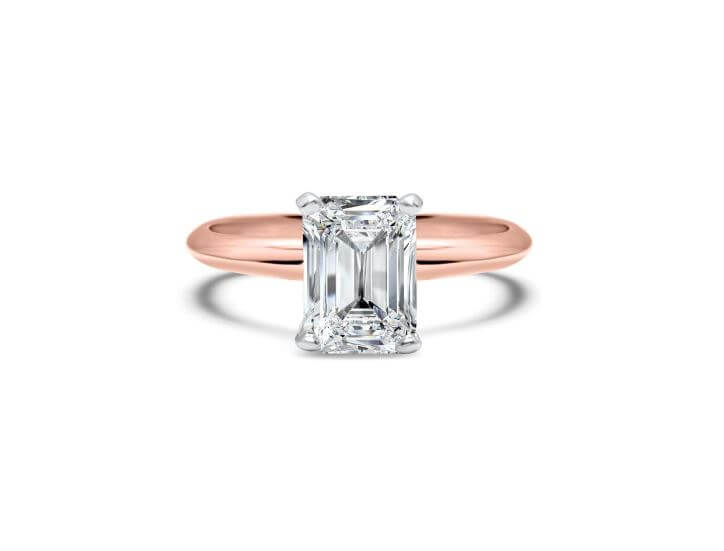
The Importance of Emerald diamond Clarity
Diamonds are formed deep within the earth, subjected to extreme pressure and heat, and because of this, mostly all diamonds contain small imperfections on the inside called inclusions or imperfections on the surface called blemishes. Diamonds which have several inclusions or blemishes tend to have less brilliance as the imperfections interfere with light entering and exiting the diamond.
Where the inclusion is located will affect if it is very visible or not. While diamond cutters try their best to cut a diamond in a way which makes the inclusions and blemishes less visible, it isn’t always possible. If there are inclusions in the stone, it is better if they fall under the bezel facets or near the girdle, where they will be harder to see.
For emerald cut diamonds, clarity is fairly subjective. The clarity grade chosen for a diamond is dependent on the client, some clients might be fine with an inclusion that isn’t very visible, and others might prefer for a flawless diamond.
The below GIA grading shows how inclusions have an effect on the grading of a diamond, and these gratings have a pronounced effect on the pricing of a diamond.
| Flawless (FL) | No visible blemishes or inclusions under 10x magnification. | These are very rare, with less than 1 in 5000 diamonds rated FL |
| Internally Flawless (IF) | There are no inclusions but blemishes are visible using 10x magnification. | Appear identical to FL unless viewed using 10 x magnifications. Less than 3% of diamonds are IF. |
| Very, Very Slightly Included (VVS1 – VVS2) | Inclusions are hardly visible under 10x magnification. | VVS1 inclusions are usually visible from the pavilion and VVS2 inclusions are usually visible from the crown. These inclusions are invisible to the eye and can be viewed under 10x magnification. |
| Very Slightly Included (VS1 – VS2) | Inclusions are visible under 10x magnification but are minor. | Inclusions are not easily visible to the naked eye. |
| Slightly Included (SI1 – SI2) | Inclusions are easily noticeable under 10x magnification. | SI1 is as low a grade possible with inclusions not visible to the naked eye. SI2 inclusions are visible to the naked eye under very close inspection. |
| Included (I1-I3) | Inclusions are mostly always visible to the naked eye. | I2-I3 diamonds have very pronounced inclusions, and this can often affect the diamond’s durability. |
Emerald cut diamonds tends to show inclusions more as they have such a large surface area. When it comes to clarity, a VS2 grade for an emerald cut diamond is a good choice and has a fair balance between appearance and price.
| Excellent | Very Good | Good | Fair | Poor | |
| Less than .50 ct. | FL – VS2 | SI1 | SI2 | I1 | Higher than I1 |
| .51-1.0 ct. | FL – VS1 | VS2 | SI1 | SI2 | Higher than SI2 |
| 1.0-2.0 ct. | FL – VVS2 | VS1 – VS2 | SI1 | SI2 | Higher than SI2 |
| Greater than 2.0ct | FL – VVS2 | VS1 | VS2 | SI1 | Higher than SI1 |
Emerald Cut Carat Weights
In order to mine a diamond large enough to be polished to a one-carat diamond, nearly one million rough diamonds have to be mined, showing how rare a one-carat diamond is. The scarcity of large diamonds results in a large price increase between the different carat weight of diamonds, with a one-carat diamond costing nearly six times as much as a half-carat diamond.
When it comes to deciding on a carat weight for your diamond, it is advised to choose quality over quantity. A larger carat weight diamond with a low-grade cut and clarity will cost less than a smaller diamond with a higher grade cut and clarity. It is so important to consider all aspects, such as cut, color, clarity and carat weight when deciding on a diamond, and not just looking for the biggest diamond of the lot.
Carat weight and diamond size do not always go hand in hand. Due to the specific cuts of diamonds, an emerald cut diamond will have a larger surface area than that of an equal carat weight round cut diamond. The length and width measurements of the diamond determine its actual size and not its weight. If a diamond has a deeper cut, the weight will be lost at the bottom of the diamond. The larger the table and the broader the diamond, the bigger the diamond will seem, almost non-dependent on the carat weight.
As the price of diamond increases as the carat weight increases, it is a good idea to look at diamonds which fall just under the popular carat weights. Look for a 0.95 ct. diamond instead of a 1.0 ct. diamond, these will be less popular and might be at a discounted price. This way you are able to save on your budget, but still have a very closely sized diamond to what you want.
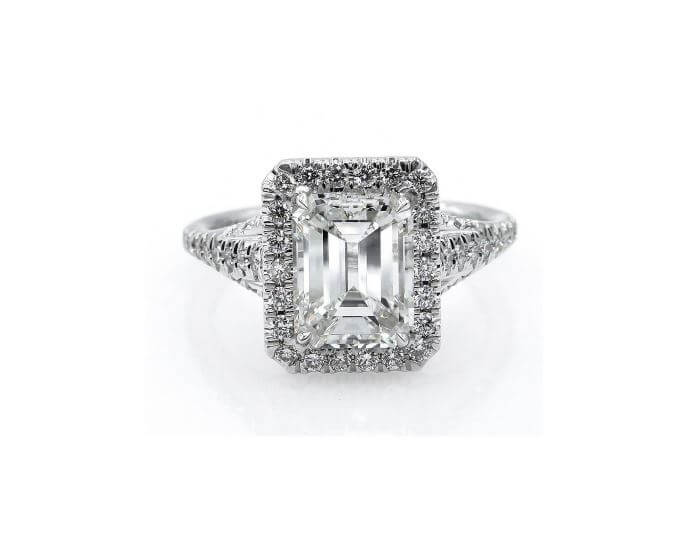
Insights into Buying an Emerald Cut Diamond
Buying an emerald diamond is a big investment, and it will do you well to ensure that you are buying a quality diamond that will be an investment for the future. An ideal cut for an emerald diamond will allow the diamond to exhibit a wonderful sparkle, and fewer inclusions and less color will only help to enhance the mirror effect of an emerald cut. These guidelines below should be followed when purchasing an emerald diamond, to ensure you are getting a quality diamond:
| Ideal Proportions | Affordable Proportions | |
| Table (%) | 61-68 | 59-70 |
| Depth (%) | 60-65 | 57-68 |
| Girdle | Very Thin to Thick | Very Thin to Thick |
| Cutlet | None | Very Small |
| Polish | Excellent to Very Good | Excellent to Very Good |
There are some worthwhile benefits of buying an emerald cut diamond. Their unique shape and design help make fingers look elongated and slender and their diameter is 5% larger than that of a round cut diamond, which makes an engagement ring seem bigger. The same carat weight between a round cut diamond and an emerald diamond will have a different appearance, with the emerald diamond seeming much larger, and you save between 15-25% on the overall cost.
What to Look Out for When Buying an Emerald Diamond
While there are things to look for when purchasing an emerald cut diamond, there are also certain features to avoid. The below need to be avoided or looked out for when buying an emerald cut diamond, as they might indicate that it is a lower quality diamond.
- Uneven corners on the diamond
- Inclusions which are visible to the naked eye
- Very thick or very thin girdle
- Poor or Fair symmetry
- A strong blue fluorescence
- No GIA or AGS certification.
The Importance of Fluorescence
Blue fluorescence can play a big role in the pricing or quality of a diamond, but it depends on the color grade which the diamond holds. Diamonds which fall in the lower color range of H or lower can actually benefit from blue fluorescence, as it could make them appear whiter and colorless. However, a diamond in the higher color range of D-G could appear hazy under specific light conditions. Therefore the benefit of fluorescent diamonds is a reduced price.
This is how fluorescent diamonds are graded by the GIA:
| Faint Fluorescence | This will have no effect on the color and overall appearance of the diamond. Faint fluorescence should not be a factor when purchasing a diamond. |
| Medium Fluorescence | Medium fluorescence will have a very small appearance of color and overall appearance of a diamond, but colorless diamonds might be negatively affected by this fluorescence. |
| Strong / Very Strong Fluorescence | Caution should be practiced when purchasing a diamond with a strong fluorescence. It is not a good idea to purchase a colorless diamond with strong fluorescence, and even lower color diamonds may appear hazy under strong fluorescence. |
The Classic Emerald Cut Diamond
You need to consider the 4 C’s when purchasing your emerald-cut diamond: cut, color, clarity, and carat. For a pure investment, try and get the highest quality in all 4 C’s as possible, as this will only exponentially increase the value of your emerald cut diamond.
If you are working within a budget, you might want to lower the color and clarity of the diamond and go for a less popular carat weight such as a 0.95 ct. diamond in order to cut back costs slightly. However, do not lower these so much that the quality and appearance of your diamond is compromised.
Emerald diamonds are among the most popular diamonds purchased. They are vintage and timeless and can be worn adorned by other gems and precious stones. Emerald cut diamonds are also more affordable than other cuts and will be a good value-for-money purchase, while still looking incredible set on its own or within an intricate design.
Be sure to check the authenticity of the diamond you are purchasing, to secure its value and quality. You also have the option of having your diamond independently certified just to make sure you are buying an emerald cut diamond of real worth.
